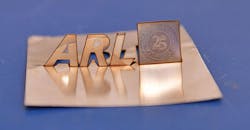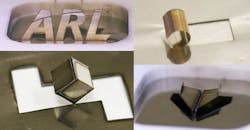Researchers at the U.S. Army Research Laboratory (ARL) have for the first time created complex 3D parts directly from a blank sheet of metal using only a laser cutter. Laser cutters typically cut 2D parts from a single sheet of material using a focused light source that heats metal so that the material leaves the surface. Instead of using this classic technique, the laser was set to a lower power level, causing controlled heating instead of cutting.
The heating causes relative expansion, which in turn lets the metal be bent in a process called laser forming. With laser forming, the direction in which the metal bends (i.e., up or down) is controlled with power and beam speed, which cannot be achieved with the traditional approach.
This process is all hands-free, low-cost, efficient, and well-suited for fabricating thousands of parts at a time.
The ARL logo was folded and positioned without human intervention by a laser cutter. (U.S. Army Photo by J Scott)
Being able to rapidly produce replacement parts without having to bring them in from elsewhere is a critical need in today’s Army, driving a variety of ARL programs at its Manufacturing at the Point of Need Essential Research Area. This research, aimed at making 3D parts, is a potential game-changer in rapidly making parts at forward bases throughout the world.
Initial demonstrations of laser forming origami have included a wide range of possible parts, from cubes and coils to arcs and cylinders. Materials that can be laser formed include metal, glass, and crystalline semiconductors.
The newest version works with thin metal and lower power lasers and could easily create a new antenna for a radio, a new inductor for a power system, or new heat sinks for cooling. With a higher-power laser, which the team is preparing for, it would be possible to build replacement armor plate for a tank, sloped and curved appropriately, or a helmet.
With further development, this technique could let complete assemblies be built in the laser cutter itself, which brings an important new function to a widely available tool.
To create these parts, instead of using this classic technique, the laser was set to a lower power level, causing controlled heating instead of cutting. The heating causes relative expansion, which in turns lets the metal be bent in a process called laser forming. (U.S. Army Photo by J Scott)
Folding 2D materials to create 3D shapes is widely used in applications ranging from balloon stents in hearts to solar panel arrays on the International Space Station. However, there are only a few limited examples of creating folded structures using laser forming, and this research has pushed far beyond what has been done previously. The technique can take a blank, unpatterned sheet of metal to a complex 3D part, including etching, cutting, and up and down folds, all with just the laser itself and no human intervention.
In addition to being a defense benefit, this technique has applications in developing countries, where needed resources are not readily available.
It is currently difficult to get modern technology to rural areas such as the developing regions of Africa. But low-cost devices, such as 3D printers and laser cutters, are far more are much easier to install in remote locations to let people there rapidly build tools and other items, and give them far more capability than a blacksmith or toolmaker. And without too much imagination, it is possible to see these same people turning out extra parts for export to neighboring villages or the rest of the world.



